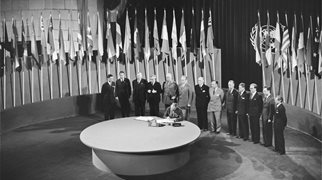Playing is Learning
The 51 Founding Countries of the UN
October 17th, 2016
| Ads | ||
|
Play the Challenge
|
||
|
A New Word is Coined A new Character is revealed A new Game is Afoot |
An Edutainment Adventure Based on Three Rounds of Investigations
|
|
|
Welcome to the World of PROFESsee™by seeCOSM™ PROFESsee™ is my title. I am the perpetual learner, in pursuit of knowledge, wisdom and truth. I derived my name from professor |
 |
|
|
So let’s gist for a while shall we? Where were you in 1945? Perhaps not yet born… But I can imagine being around then how much elation the end of the war would have brought to me (that is if I hadn’t been a victim). How would you have jubilated in the midst of the euphoria back then? With the fall of Berlin and Japan’s unconditional surrender in 1945, World War II came to an end. With it, territorial lines were receding like the hairs on a bald head (No offence, but I’m a bald person myself), and territories breaking up like a lover’s heart shattered to pieces. This dynamic flux affected the territorial integrity of countries. Before we get ahead of ourselves, let’s define what a country is. A country is a sovereign state – that is, it has a centralized government and holds sovereign power over a geographic area. It follows, that while entities existed back then that could have qualified as countries, they aren’t classified such because they were under the sovereignty of other Sovereign powers. As I said, the territorial lines were in flux, especially for those countries involved heavily in the war. Countries like The Netherlands, Denmark and Norway survived this state of flux, as their territorial boundaries remained the same. But countries like Poland, Yugoslavia and Czechoslovakia were annexed off the map by Germany’s allied forces even though they retained their country status afterwards. In Europe, sovereign territories were no longer recognizable – Europe became a blend of Sovereign states and occupied territories like Poland. By 1945, Europe only had 15 countries on the world map of 1945 including Turkey (the mixed breed – Asia and Europe). Despite the shifting momentum in favor of independent states, most entities in the Middle East and Africa were still under colonial powers as at 1945. As a result, few countries in the Middle East made it to San Francisco namely Lebanon, Syria, Iraq, Iran, and Saudi Arabia, and four countries from Africa made the cut, namely Egypt, Liberia, South Africa and Ethiopia. So, let’s do a roundup of the remaining countries from the other continents to make the grade as a country on the 1945 world map. Northern America had a total of 12 countries includes the United States and Haiti. In South America, there were 10 countries representing including Argentina and Brazil. In Oceania, only New Zealand and Australia were sovereign states as at 1945. While I would have loved to list all the 51 countries on the map, I’m frankly too lazy for that at the moment. But you sure get the gist of the map in 1945. Don’t you? Can you Assemble the 51 countries? Image courtesy of: http://www.un.org/en/about-un/ |
||
Latest News / Events
E-mail [email protected]
The Professee™ Newsletter Beta
http://www.seecosm.com/
http://www.seecosm.com/

